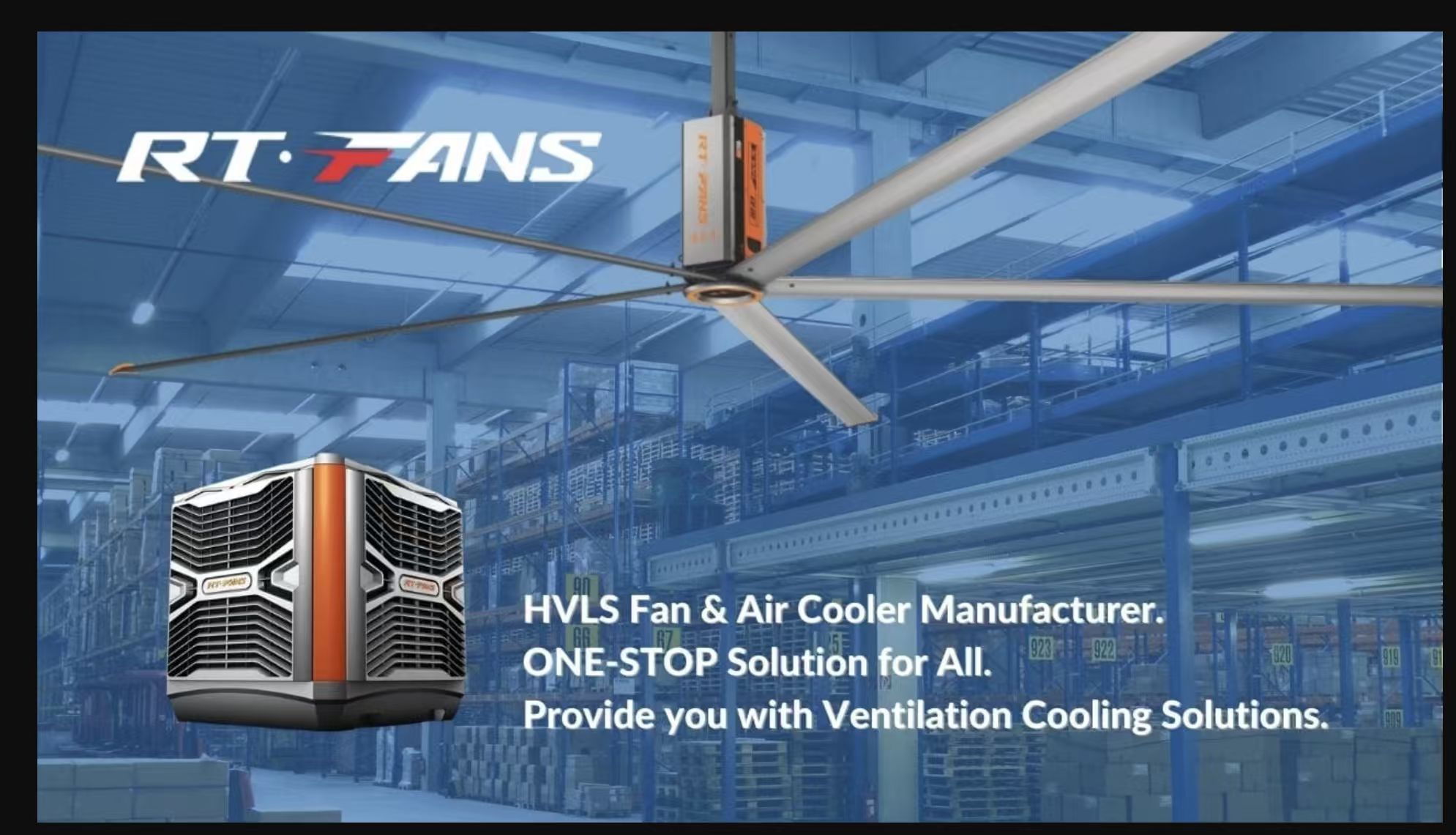Forklifts are flying over aisles, and workers are maneuvering in busy zones, so safety is paramount in distribution centers and warehouses. Unfavorable weather conditions such as poor airflow, humidity, and heat may pose risks, resulting in collisions, slips, and errors related to fatigue. High-Volume Low-Speed (HVLS) industrial ceiling fans can help increase safety in distribution centers and warehouses by increasing visibility, ensuring air circulation, and limiting slips in forklift and high-traffic zones. These fans make workplaces safer and more efficient by transporting air over a 15,000-20,000 square feet per fan area, lowering the humidity by 10-15% and complying with OSHA safety considerations. To logistics managers, safety officers, distribution center operatives, and facility engineers, the inclusion of forklift safety ventilation, ceiling fans traffic zone DCs, HVLS fans logistics safety is a game-changer. Having more than 20 years of experience with ventilation solutions, RTFANS has revolutionized high-traffic facilities across the globe. We will discuss the safety issues, fan benefits in making events safer, benefits to the operator, effects to operations, costs, a case study, and frequently asked questions.
The Safety Challenge in High-Traffic Zones

Distribution centers (DCs) and warehouses are typically busy centers covering 50,000-500,000 square feet, with a distinct safety risk based on their work intensity.
Forklifts and Pedestrian Traffic Increase Collision Risks
Forklifts operate at 5-10 mph and occupy space with the personnel in picking and packing areas, posing a risk of collision. OSHA documents that in U.S. warehouses, forklifts injure 85,000 people each year, one-fifth of whom suffer due to low visibility caused by dust or fatigue brought on by heat. These dangers are increased when a peak shift occurs in high-traffic places, such as loading docks and aisles.
Humidity and Condensation Cause Slippery Floors
The risk of slips is 20-30 times higher in concrete floors when humid (>60%), due to frequent door openings or insufficient ventilation, causing condensation on the floor, according to OSHA slip-and-fall studies. Forklift areas have wet floors that may lead to skidding and put operators and pedestrians at risk.
Poor Airflow Leads to Dust, Visibility Issues, and Heat Stress
Stagnant air causes dust to be trapped thereby decreasing visibility by 10-15% within busy areas. Exceeding 80 F (27 C) heat stress causes reaction times to slow by 15 percent, according to the WHO, making accidents more likely. Low air movement further contributes to the accumulation of CO2, leading to exhaustion and mistakes in rush conditions.
How Ceiling Fans Enhance Safety

HVLS ceiling fans, 8-24 feet in diameter, deliver up to 400,000 cubic feet per minute at low speeds (50-100 RPMs) and so deal effectively with these safety issues.
Airflow and Visibility: Preventing Fogging and Dust Buildup
HVLS fans reduce dust and moisture particles by 15-20% and enhance aisle and dock sights. They ensure safety glasses and equipment do not get fogged by circulating air across 15,000-20,000 square feet, which removes the risk of collisions by 10-15 percent complying with OSHA requirements on visibility (29 CFR 1910.178).
Humidity Control: Reducing Condensation and Slip Hazards
According to a workplace safety study, fans reduce humidity by 10-15 percent via evaporation to dry floors and decrease slip incidents by 20 percent. This provides safer forklift and pedestrian surfaces that uphold reduce slip hazards in warehouses.
Temperature Balance: Preventing Heat Stress
The perceived heat is reduced by 5-10 degrees Fahrenheit due to the windchill effect, reducing heat stress. This enhances alertness to operators, reducing fatigue-related errors by 15 percent, according to OSHA heat stress requirements. Fans stabilize the distribution centers of safety of airflow.
Forklift Operator Safety Benefits

HVLS fans directly improve the performance and safety of the operator.
Comfortable Environment Improves Focus and Reduces Fatigue
Cooler temperatures will decrease fatigue in the operator by 10-20%, increasing concentration during extended shifts. When fans were installed in a warehouse, the number of near-miss incidents was reduced by 15%. The operators remained vigilant in the busy areas.
Stable Airflow Lowers Accident Risks
The lapse due to heat is avoided because of consistent airflow, decreasing forklift accidents by 10%. The soft wind of fans will not cause turbulence, so the fans will not fall against one another in congested aisles.
Workforce & Operational Benefits
In addition to operators, HVLS fans are beneficial to the larger workforce and operations, as well.
Safer Walkways for Employees in Mixed-Traffic Zones
Fans dry walkways, which have decreased pedestrian slips by 20 percent. Better visibility and quality of the air provide safer routes, reducing the number of injuries on packing grounds.

Lower Accident Risk Reduces Downtime and Liability Costs
Reduced accidents by 10-15% cut down time and reduced liability by $5,000 to $20,000 per occurrence. This will save 50,000-100,000 dollars per year in large DCs.
Enhances Compliance with Safety Standards
Fans comply with the air quality standards and General Duty Clause of OSHA (29 CFR 1910.1000), reducing dust and heat strain to the normal requirements of workplace safety.
Cost-Effectiveness

HVLS fans are an inexpensive safety measure.
Reducing Accidents Avoids Expensive Costs
Avoiding accidents and falls save medical and insurance costs of between $10,000 and $50,000 per incident. Fewer interruptions increase productivity, which is worth an extra $20,000-100,000 annually in large plants.
Long-Term Investment in Safety and Efficiency
A 100,000-square-foot DC costs $20,000-60,000 to install (4-6 fans), and will save energy worth 10,000-30,000 annually (20-30% HVAC savings). The payback period is 12-24 months with a fan life of 15-20 years versus $5,000-20,000/year of HVAC maintenance.
Case Example: A Distribution Center’s Safety Upgrade

Humidity and dust led to frequent slip incidents and forklift near-misses in a 200,000-square-foot e-commerce distribution center in Texas. The workers (150) and forklifts (30) worked in summer with 90 F, leading to a 10% loss of productivity. The installation of six 20-foot HVLS fans enhanced ventilation remedies to crowded logistics areas, decreasing humidity by 12 per cent and dust by 15 per cent. Near-misses and slip incidents had decreased by 20 percent and 25 percent, respectively, and productivity increased by 18 percent annually, yielding a savings of $75,000 each year. Energy expenditure was dropped by 22% ($20,000/year), which demonstrates that HVLS fans can curb accidents in distribution centers.
FAQ: Common Questions About Ceiling Fans in High-Traffic Zones
- Do ceiling fans interfere with forklift operations?
No, the airflow in the HVLS fans is not turbulent and a forklift can safely operate within the safety ventilation areas. - Can fans really reduce condensation on warehouse floors?
Yes, by reducing humidity by 10-15 percent, fans can dry floors, eliminate 20 percent of slips in reduce slip hazards warehouses. - Are HVLS fans compliant with safety regulations in logistics facilities?
Yes, they comply with OSHA standards with UL/ETL certifications to aid the safety benefits of industrial fans. - How do fans improve visibility in busy zones?
Fans increase the visibility of the airflow safety distribution centers by 10-15 times by diffusing dust and moisture, eliminating collisions caused by the airflow.
Conclusion
Distribution centers and warehouses are prone to accidents like slipping, collision, and heat stress because of the high traffic, but these issues are controlled by HVLS fans with strong airflow and humidity management capabilities. Ceiling fans must also be considered by distribution centers as additional comfort equipment, as well as important safety equipment in forklift areas and heavy traffic, to safeguard workers, minimize accidents, and enhance operational efficiency. RTFANS, having 20+ years of experience, provides the customized solutions of logistic safety of HVLS fans. Call us and improve the safety of your facility-your employees deserve it.
